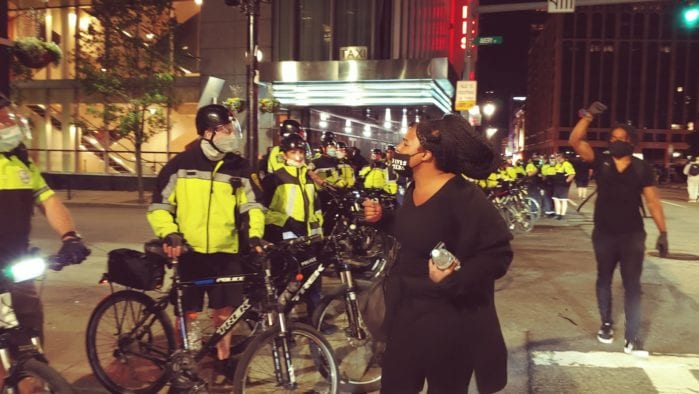
It’s Systemic
Racist policing is a symptom, but it’s not the disease, not in Milwaukee, not in Nashville, not in Somerville. Racist systems are the disease, and without curing the disease, we are doomed to play whack a mole with the symptoms.
Somerville School Committee Representative Andre Green said that at a vigil last month, and I want to tell you why I think he’s right. The development of U.S. policing over the last two and a half centuries is inextricably linked to the management of economic and racial inequality. This has become increasingly so over the last forty years as government has largely abandoned its role in reducing inequality.
Blaming police for pernicious behaviors and proposing specific reforms to correct them will come to little without understanding that those behaviors are the outcomes of the systemic role that society’s most powerful have mandated for policing.
The “system” is, first, the interlocking set of institutions that make up law enforcement. And then it is the larger economic, political, and social institutions in which law enforcement is fully integrated and preserves, which will be dealt with in subsequent columns.
Police Academies
The problem with the “few bad apples” theory of police misconduct is that police departments rarely hire bad apples. A team of psychologists found that before entering police academy, recruits tested higher on integrity than did the college students who had participated in the integrity scale’s development.
This finding built on an earlier study. It found that police academy recruits’ most common motivations were helping others and obtaining job benefits.
At the academies, a majority of which are modeled on military boot camps, recruits begin their socialization to police culture. At most academies emphasis is on discipline, appearance, rote learning of rules, and especially “officer safety.” Much less common is effective guidance about how to make real-time decisions in a complex environment.
Police Departments
Academy graduates enter one of the country’s 17,000 independent police departments that as a group are historically defensive, secretive, and insular. New officers enter a culture in which civilians are viewed cynically, creating an us-versus-them mentality.
The Pew Research Center finds that 84% of officers worry about their safety at least some of the time, 86% say that they don’t think the public understands their risks and challenges, and 67% report that they have been verbally abused by a member of their community sometime during the previous month. Only about 4% of police time is spent on violent crime, and only 27% of officers report having discharged their firearm while on duty at some point over their entire career.
Guidelines for when and how to use force vary enormously across departments, although it is possible to provide specific guidance for such varied situations as traffic stops, arrests, and dealing with people who are mentally ill.
It is difficult to understate how decisive peer pressure is in either curtailing misconduct, or in perpetuating it by protecting malefactors. Experts and progressive police leaders increasingly advocate a cultural shift to officers as guardians vs. as warriors, emphasizing “communication over control, cooperation over compliance, and legitimacy over authority.”
The warrior culture and poor use-of-force guidance are at least two reasons why police in the U.S. kill 1,000 people annually, while in contrast, for example, Great Britain’s police have killed fewer than 60 since 1900.
Police unions and politicians
Police unions have been remarkably effective in protecting members accused of misconduct and reinforcing the blue wall of silence. They have mobilized political clout and collective-bargaining agreements to prevent investigation, discipline, and termination of offending officers. When disciplinary sanctions are imposed, grievance and arbitration procedures often reduce or eliminate them.
Recognizing police unions as a potent political constituency, politicians maintain laws that protect such procedures while sharply limiting public access to disciplinary files or use-of-force investigations.
State politicians bear another responsibility. States could create statutes that more specifically define legal uses of force, giving officers latitude to protect themselves and others while prohibiting them from acting purely on fear and speculation. They have not.
District Attorneys
The close working relationship between prosecutors and police is normally an asset. It becomes a conflict of interest when the crime is police misconduct, disincentivizing prosecutors from aggressively pursuing cases. Moreover, elected district attorneys are reluctant to be seen by the electorate as unsupportive of the police.
Overly broad laws have enabled prosecutors working with police to criminalize ever more behaviors and populations, supported by disproved ideologies like the broken window hypothesis. Making matters worse, district attorneys routinely overcharge, prosecuting minor non-violent offenses as felonies.
Progressive prosecutors who are elected on reform platforms encounter persecution and undermining by police unions and politicians.
Courts
In the absence of statutes clearly defining legal police use of force, state and federal governments regulate it through court decisions, and judges often share membership in the same implicit fraternity as police and prosecutors.
The Supreme Court’s Graham v. Connor (1989) ruling means that police can use force in response to anything that might be interpreted as resistance to arrest. Since then courts have expanded the doctrine of qualified immunity, which protects officers who violate someone’s constitutional rights from civil-rights lawsuits. This week the Supreme Court refused to reconsider this doctrine.
Analyzing court records, Reuters found that since 2005, appellate courts have shown an increasing tendency to grant immunity in excessive force police cases. All courts below them must follow these rulings.
Prisons
To discuss the role that prisons play in the system—and their human toll—would require multiple columns. They are much more about retribution than public safety, about the consequences of oppression rather than the pursuit justice.
The prisoner population got a huge boost with Bill Clinton’s crime bills, which came with $8 billion for new prisons. A profitable growth industry, state and federal prisons increased from 1,277 in 1990 to 1,821 in 2005, or one every ten days. It’s the only economic development tactic in many rural areas.
Meanwhile, violent crime rates plummeted by 70% between 1993 and 2018, and police are safer than they have been at any point during the last fifty years. Nevertheless, the prison business thrives due to overcharging, continued prosecution of the failed war on drugs, warehousing of the mentally ill, and criminalization of ever more behaviors, including illegal entry into the U.S.
There are ten times as many mentally ill people in prisons and jails as in state hospitals. And criminal prosecutions for illegal entry have exploded from 13,249 in 2002 to 99,479 in 2018.
There are now 2.3 million people imprisoned in the U.S., more than any other country by far, including the worst authoritarian regimes . The lives of prisoners who reemerge will be damaged in terms of mental wellbeing, employability, family ties, and probable future criminality.
The foregoing institutions synergize to comprise the “criminal justice system.” Movements are now surging to “defund the police,” or “abolish the police.” Specific objectives vary when one examines differing initiatives, and of course it is not possible to simply decree the abolition of this system and replace it with a better world.
What I understand the intent to be instead is a transformative process. Responsibilities that politicians have thrust upon the criminal justice system for dealing with homelessness, mental illness, drug addiction, school discipline, immigration, and other societal challenges be humanely dealt with instead by caring professionals with skills best suited to each challenge.
But I would encourage the following thought experiment. Imagine that as much as possible, prosecutors, judges, and police, correctional, and probation officers were replaced with care givers. Could the care givers provide decent housing, or living-wage jobs, or good healthcare, or fair labor practices, or equal treatment across our institutions to all those who need them?
Doing so would require the transformation of our economic and political institutions, which is the larger system to which I believe that Andre Green’s opening remarks referred. The net effect would be a vast redistribution of wealth and power.
It is the prevention of such a transformation for which policing in the U.S. was historically created and deployed, with the consequences that are now apparent to increasingly more citizens, despite the best intentions of so many police officers. That history is the subject of the next column in this series.
READ THE WHOLE SERIES!
Bridging the chasm between law and justice
Bill Shelton lives in Somerville, where he sits on the Union Square Neighborhood Council and has been a trouble maker for 32 years.

